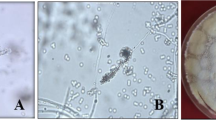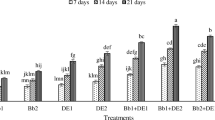Abstract
Use of the mycopathogen Beauveria bassiana (strain GHA), marketed as BotaniGard® ES, was evaluated as a plant protection strategy against the spider mite Tetranychus urticae Koch, which is considered one of the most economically important and cosmopolitan pests of many crops. Tetranychus urticae were treated with four concentrations of conidia (1 × 105, 1 × 106, 1 × 107, or 1 × 108 conidia/ml), and virulence was assessed on mites held at four relative humidity levels (35, 55, 75, and 95 ± 2 % RH) at 25 ± 1 °C. At 1 × 108 spores/ml, the LT50 value was 9.7 h at 95 % RH, which was significantly lower than values for other RH levels. At 1 × 107 spores/ml, the LT50 value was 43.8 h at 95 % RH, which was significantly different from values at 55 and 35 % RH. The efficacy of B. bassiana product was also verified on mites infesting potted bean plants with a concentration of 1 × 108 spores/ml. In double spray treatment where applications were made 2 × on days 5 and 10 after mite infestation, the nymphal and adult population of T. urticae were reduced to zero on days 20 and 15, respectively. With a single spray on day 5, the nymphal population was also greatly reduced, but increased rapidly after day 20. Single and double sprays with B. bassiana reduced leaf damage as measured by image analysis by 33 and 94 % compared to no treatment, respectively. These results suggest that 1 × 108 spores/ml was the most effective dose and that two applications, at a 5-day interval, provided control of T. urticae in our laboratory assay.




Similar content being viewed by others
References
Abbott SW (1925) A method of computing the effectiveness of an insecticide. J Econ Entomol 18:265–267
Almeida JEM, Alves SB, Pereira RM (1997) Selection of Beauveria spp. isolates for control of the termite Heterotermes tenuis (Hagen, 1858). J Appl Entomol 121:539–543
Alves SB, Rossi LS, Lopes RB, Tamai MA, Pereira RM (2002) Beauveria bassiana yeast phase on agar medium and its pathogenicity against Diatraea saccharalis (Lepidoptera: Crambidae) and Tetranychus urticae (Acari: Tetranychidae). J Invert Pathol 81:70–77
Alves SB, Tamai MA, Rossi LS, Castiglioni E (2005) Beauveria bassiana pathogencity to the citrus rust mite Phyllocoptruta olivora. Exp Appl Acarol 37:117–122
Andreeva IV, Shternshis MV (1995) Micro biological formulations against web mites in greenhouses. Zaschitarastenii Moskva 11:41–42
Aponte O, Mcmurtry JA (1997) Damage on ‘Hass’ avocado leaves, webbing and nesting behaviour of Oligonychus perseae (Acari: Tetranychidae). Exp Appl Acarol 21:265–272
Benz G (1987) Environment. In: Fuxa JR, Tanada Y (eds) Epizootiology of insect diseases. John Wiley and Sons, New York, pp 177–214
Chandler D, Davidson G, Jakobson RJ (2005) Laboratory and glasshouse evaluation of entomopathogenic fungi against the twospotted spider mite, Tetranychus urticae (Acari: Tetranychidae), on tomato, Lycopersicon esculentum. Biocontrol Sci Technol 15:37–54
Devi KU, Rao CUM (2006) Allee effect in the infection dynamics of the entomopathogenic fungus Beauveria bassiana (Bals) Vuill. on the beetle, Mylabris pustulata. Mycopathologia 161:385–394
Dunn PH, Mechalas BJ (1963) The potential of Beauveria bassiana (Balsamo Vuill.) as a microbial insecticide. J Invert Pathol 5:451–459
Faria M, Wraight SP (2001) Biological control of Bemisia tabaci with fungi. Crop Prot 20:767–778
Feng MG, Chen B, Ying SH (2004) Trials of Beauveria bassiana, Paecilomyces fumosoroseus and imidacloprid for management of Trialeurodes vaporariorum (Homoptera: Aleyrodidae) on greenhouse grown lettuce. Biocontrol Sci Tech 14:531–544
Ferron P (1977) Influence of relative humidity on the development of fungal infection caused by Beauveria bassiana (Fungi imperfecti, Moniliales) in imagines of Acathoscelides obtectus (Col.: Bruchidae). Entomophaga 22:393–396
Ferron P, Fargues J, Riba G (1991) Fungi as microbial insecticides against pests. In: Arora DK, Ajello L, Mukerji KG (eds) Handbook of applied mycology, humans, animals and insects, vol 2. Marcel Dekker Inc., New York, pp 665–705
Gatarayiha MC, Laing MD, Miller RM (2011) Field evaluation of Beauveria bassiana efficacy for the control of Tetranychus urticae Koch (Acari: Tetranychidae). J Appl Entomol 135:582–592
Grbić M, Van Leeuwen T et al (2011) The genome of Tetranychus urticae reveals herbivorous pest adaptations. Nature 479:487–492
Groden E, Wraight SP, Drummond FA (2002) Microbial control of Colorado potato beetle in potatoes in rain-fed potato agroecosystems in the Northeastern US. Proceedings, international colloquium on invertebrate pathology and microbial control, Foz do Iguacu, Brazil 8, pp 265–269
Hatting JL, Wraight SP, Miller RM (2004) Efficacy of Beauveria bassiana (Hyphomycetes) for control of Russian wheat aphid (Homoptera: Aphididae) on resistant wheat under field conditions. Biocontrol Sci Technol 14:459–473
Inglis DG, Goettel SM, Butt MT, Strasser H (2001) Use of Hyphomycetes fungi for managing insect pests. In: Butt TM, Jackson C, Magan N (eds) Fungi as biocontrol agents. CABI Publishing, Wallingford, pp 23–27
James RR, Buckner JS, Freeman TP (2003) Cuticular lipids and silverleaf whitefly stage affect conidial germination of Beauveria bassiana and Paecilomyces fumosoroseus. J Invert Pathol 84:67–74
Kavousi A, Chi H, Talebi K, Bandani A, Ashouri A, Naveh VH (2009) Demographic traits of Tetranychus urticae (Acari:Tetranychidae) on leaf discs and whole leaves. J Econ Entomol 102:595–601
LeOra Software (1987) POLO-PC. A user’s guide to probit or logit analysis. LeOra Software Inc., Berkeley 22
Marcandier S, Khachatourians GG (1987) Susceptibility of migratory grasshopper, Melanoplus sanguinipes (Fab.) (Orthoptera: Acrididae), to Beauveria bassiana (Bals.) Vuillemin (Hyphomycetes): influence of relative humidity. Can Entomol 119:901–907
Migeon A, Dorkeld F (2014) Spider mites web: a comprehensive database for the Tetranychidae. http://www.montpellier.inra.fr/CBGP/spmweb. Accessed 01 July 2014
Moino A Jr, Alves SB, Pereira RM (1998) Efficacy of Beauveria bassiana (Balsamo) Vuillemin isolates for control of stored-grain pests. J Appl Entomol 122:301–305
Moore GE (1973) Pathogenicity of three entomogenous fungi to southern pine beetle at various temperatures and humidities. Environ Entomol 2:54–57
Pereira A, Casals P, Salazar AM, Gerding M (2011) Virulence and pre-lethal reproductive effects of Metarhizium anisopliae var. anisopliae on Pseudococcus viburni (Hemiptera: Pseudococcidae). Chilean J Agric Res 71:554–559
Pu XY, Feng MG, Shi CH (2005) Impact of three application methods on the field efficacy of a Beauveria bassiana- based mycoinsecticide against the false-eye leafhopper, Empoasca vitis (Homoptera: Cicadellidae) in tea canopy. Crop Prot 24:167–175
Ramoska WA (1984) The influence of relative humidity on Beauveria bassiana infectivity and replication in the chinch bug, Blissus leucopterus. J Invert Pathol 43:389–394
Robertson JL, Russell RM, Preisler HK, Savin E (2007) Bioassays with arthropods, 2nd edn. CRC Press, Boca Raton
Rockland LB (1960) Relative humidity variations with temperature of saturated salt solutions. Analyt Chem 32:1375–1376
SAS Institute (2000) SAS user’s guide: statistics, version 9.2. SAS Institute, Cary
Scholte E-J, Njiru BN, Smallegange RC, Takken W, Knols BGJ (2003) Infection of adult malaria (Anopheles gambiae s.s.) and filariasis (Culex quinquefasciatus) vectors with the entomopathogenic fungus Metarhizium anisopliae. Malar J 2:29
Seiedy M, Saboori A, Allahyari H, Talaei-Hassanloui R, Tork M (2010) Laboratory investigation on the virulence of two isolates of the entomopathogenic fungus Beauveria bassiana against the two spotted spider mite Tetranychus urticae (Acari: Tetranychidae). Int J Acarol 36:527–532
Shi WB, Feng MG (2006) Field efficacy of application of Beauveria bassiana formulation and low rate of pyribaden for sustainable control of citrus red mite Panonychus citri (Acari: Tetranychidae) in orchards. Biol Control 39:210–217
Shi WB, Feng MG (2009) Effects of fungal infection on reproductive potential and survival time of Tetranychus urticae (Acari: Tetranychidae). Exp Appl Acarol 48:229–237
Shi WB, Feng MG, Liu SS (2008) Sprays of emulsifiable Beauveria bassiana formulation are ovicidal towards Tetranychus urticae (Acari:Tetranychidae) at various regimes of temperature and humidity. Exp Appl Acarol 46:247–257
Shipp JL, Zhang Y, Hunt DWA, Ferguson G (2003) Influence of humidity and greenhouse microclimate on the efficacy of Beauveria bassiana (Balsamo) for control of greenhouse arthropod pests. Environ Entomol 32:1154–1163
Tamai MA, Alves NB, Neves PS (1999) Pathogenicity of Beauveria bassiana (Bals.) Vuill. against Tetranychus urticae Koch. Sci Agric 56:285–288
Toledo AV, Alippi AM, Remes Lenicov AMM (2011) Growth inhibition of Beauveria bassiana by bacteria isolated from the cuticular surface of the corn leafhopper, Dalbulus maidis and the planthopper, Delphacodes kuscheli, two important vectors of maize pathogens. J Insect Sci 11:29
Ullah MS, Haque MA, Nachman G, Gotoh T (2012) Temperature-dependent development and reproductive traits of Tetranychus macfarlanei (Acari: Tetranychidae). Exp Appl Acarol 56:327–344
Van Leeuwen T, Vontas J, Tsagkarakou A, Dermauw W, Tirry L (2010) Acaricide resistance mechanisms in the two-spotted spider mite Tetranychus urticae and other important Acari: a review. Insect Biochem Mol Biol 40:563–572
Willmer P (1986) Microclimatic effects on insects at the plant surface. In: Juniper B, Southwood R (eds) Insects and the plant surface. Edward Arnold, London, pp 65–80
Acknowledgments
Mohammad Shaef Ullah was supported by the BK21 plus program of Ministry of Education, Science, and Technology, Republic of Korea.
Author information
Authors and Affiliations
Corresponding author
Rights and permissions
About this article
Cite this article
Ullah, M.S., Lim, U.T. Laboratory bioassay of Beauveria bassiana against Tetranychus urticae (Acari: Tetranychidae) on leaf discs and potted bean plants. Exp Appl Acarol 65, 307–318 (2015). https://doi.org/10.1007/s10493-014-9871-2
Received:
Accepted:
Published:
Issue Date:
DOI: https://doi.org/10.1007/s10493-014-9871-2




